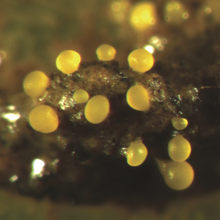Myxobacteria
| Myxobacteria | |
|---|---|

| |
| Myxococcus xanthus | |
| Scientific classification | |
| Domain: | Bacteria |
| Phylum: | Myxococcota |
| Class: | Myxococcia Waite et al. 2020[1] |
| Order: | Myxococcales Tchan et al. 1948 |
| Families & genera | |
| |
| Synonyms | |
|
"Myxococcidae" Cavalier-Smith 2020 | |
The myxobacteria ("slime bacteria") are a group of bacteria that predominantly live in the soil and feed on insoluble organic substances. The myxobacteria have very large genomes relative to other bacteria, e.g. 9–10 million nucleotides except for Anaeromyxobacter[2] and Vulgatibacter.[3] One species of myxobacteria, Minicystis rosea,[4] has the largest known bacterial genome with over 16 million nucleotides. The second largest is another myxobacteria Sorangium cellulosum.[5][6]
Myxobacteria can move by
Myxobacteria are used to study the polysaccharide production in gram-negative bacteria like the model Myxococcus xanthus which have four different mechanisms[9] of polysaccharide secretion and where a new Wzx/Wzy mechanism producing a new polysaccharide was identified in 2020.[9]
Myxobacteria are also good models to study the multicellularity in the bacterial world.[10]
Life cycle
When nutrients are scarce, myxobacterial cells aggregate into fruiting bodies (not to be confused with
At a molecular level, initiation of fruiting body development in Myxococcus xanthus is regulated by Pxr sRNA.[13][14]
Myxobacteria such as
It has been suggested that the last common ancestor of myxobacteria was an aerobe and that their anaerobic predecessors lived syntrophically with early eukaryotes.[16]
Clinical use
Myxobacteria are also known to produce gephyronic acid, an inhibitor of eukaryotic protein synthesis and a potential agent for cancer chemotherapy.[18]
Phylogeny
The currently accepted taxonomy is based on the List of Prokaryotic names with Standing in Nomenclature (LPSN)[19] and National Center for Biotechnology Information (NCBI)[20]
| 16S rRNA based | 120 marker proteins based GTDB 08-RS214[24][25][26] | ||||||||||||||||||||||||||||||||||||||||||||||||||||||||||||||||||||||||||||||||||||||||||||||||||||||||||||
|---|---|---|---|---|---|---|---|---|---|---|---|---|---|---|---|---|---|---|---|---|---|---|---|---|---|---|---|---|---|---|---|---|---|---|---|---|---|---|---|---|---|---|---|---|---|---|---|---|---|---|---|---|---|---|---|---|---|---|---|---|---|---|---|---|---|---|---|---|---|---|---|---|---|---|---|---|---|---|---|---|---|---|---|---|---|---|---|---|---|---|---|---|---|---|---|---|---|---|---|---|---|---|---|---|---|---|---|---|---|
|
|
See also
References
- PMID 33151140.
- PMID 18461135.
- ^ "Vulgatibacter incomptus strain DSM 27710, complete genome". 2015-08-19.
{{cite journal}}: Cite journal requires|journal=(help) - PMID 34511070.
- PMID 17965706.
- PMID 25722247.
- PMID 20508248.
- S2CID 34964313.
- ^ PMID 32516311.
- PMID 32516311.
- S2CID 18846289.
- PMID 16061806.
- PMID 20489016.
- S2CID 4371886.
- ISSN 0006-8071.
- PMID 34131078.
- ^ "FDA Approval for Ixabepilone". National Cancer Institute.
- PMID 7868385.
- ^ J.P. Euzéby. "Deltaproteobacteria". List of Prokaryotic names with Standing in Nomenclature (LPSN). Retrieved 2022-09-09.
- ^ Sayers; et al. "Deltaproteobacteria". National Center for Biotechnology Information (NCBI) taxonomy database. Retrieved 2022-09-09.
- ^ "The LTP". Retrieved 20 November 2023.
- ^ "LTP_all tree in newick format". Retrieved 20 November 2023.
- ^ "LTP_08_2023 Release Notes" (PDF). Retrieved 20 November 2023.
- ^ "GTDB release 08-RS214". Genome Taxonomy Database. Retrieved 10 May 2023.
- ^ "bac120_r214.sp_label". Genome Taxonomy Database. Retrieved 10 May 2023.
- ^ "Taxon History". Genome Taxonomy Database. Retrieved 10 May 2023.




